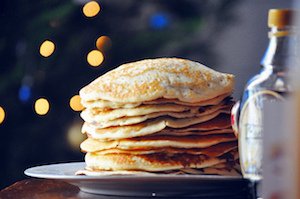An American (Pancake) in Paris: The book
 Pancakes in Paris is billed as the story of Craig Carlson “the last person anyone would expect to open an American diner in Paris.” And for good reason. Craig is not French. He had no experience running any sort of business, no idea how to navigate the notorious French bureaucracy. But the Franco-phile eventually opened not one but three diners by way of his determination, grit, smarts and prodigious work – 18 hours daily – until he collapsed in the street to regroup. Today his Breakfast in America diners, now renowned tourist destinations, allow him to live both in Paris and California where he awaits a film deal.
Pancakes in Paris is billed as the story of Craig Carlson “the last person anyone would expect to open an American diner in Paris.” And for good reason. Craig is not French. He had no experience running any sort of business, no idea how to navigate the notorious French bureaucracy. But the Franco-phile eventually opened not one but three diners by way of his determination, grit, smarts and prodigious work – 18 hours daily – until he collapsed in the street to regroup. Today his Breakfast in America diners, now renowned tourist destinations, allow him to live both in Paris and California where he awaits a film deal.

Craig tackles the seemingly impossible-from raising funding money, to tracking down international suppliers for ‘exotic’ American ingredients, scout and secure locations and round up a working staff. For more information please see: www.pancakesinparis.com or www.breakfast-in-america.com.
I have only the utmost respect, admiration for his work, including his mission accomplished: “Since its opening, Breakfast in America has become a cultural cross-roads between conflicted countries …”
However, with Paris, the city of croissants and crepes, how really did an American Pancake in Paris fare and fit in? — I would have liked to “see on the menu” much more of his research into the “authentic” American diner; how his Paris menu evolved; the international customers, the details of his business in France, which are summed up in ” different management.” After all, it is his raison d’être for his life work. The fascinating and well-detailed account of Craig’s “worker vs. boss” experience in France didn’t jive with what he saw in other French restaurants but his new methods were never shared . Craig’s personal life written in detailed confessional style would have been more palatable as a separate section though perhaps “this is the stuff of which screenplay sales are made.”

His recounting of a kind of anecdotal, casual is most frustrating. And Carlson took ten years to research and write the book.
For example, Carlson notes that “perhaps the one place that inspired me the most was the Hollywood Hills coffee shop (now the ‘101’).” Then he references it as a film location! The “volumes of information” he received center around serving fresh not frozen vegetables. It would have done him well to talk to cafe creator, Susan Fine Moore, a wealth of information, (she also created the Cadillac Cafe among other ground-breaking eateries, and knows “the French kitchen” intimately from being the first woman and later a mainstay at the legendary L’Heritage). She could have told him more than from his disparate sources and meals combined.
Craig includes a couple of dish descriptions from Astro’s Family Restaurant in Silver lake but fails to get its connection (Greek father-son) with Jan’s (On Beverly Boulevard), which he lumps into a haphazard list with Canter’s deli, not a coffee shop at all. The subject is so promising and perhaps it was not meant to be a culinary-culture book such as the brilliant “Save the Deli” or “Kitchen Confidential” or “Hotel Bemelmans.”
The key to Craig’s survival Polish-heritage work ethic and his personality are summed up in a life-altering experiences during his college time abroad. During a student excursion to an “incredible experience” at the Fouire Gastronomique (food fair) in Dijon, where his “palate awakened” he discovers that “ food became more than just something that keeps you alive.” Most importantly however, was learning the phrase “Il faut en profiter.” To the French it meant, “life life to the fullest. ” To Craig it meant, “Carpe Diem – seize the day- of which he was already a master and no matter how “lucky” he claims to be with opportunities, he was attuned to them and pushed through no matter what.
So the page-turner part of the book comes with Craig’s long hard slog for investment capital, obtaining a commercial visa (“for which you need proof of company ownership; but to make a company official, you need a commercial visa. And if your application is rejected, you get taxed on that!… ), the frustration of not being able to source American staples, like peanut butter and pumpkin pie in Paris.
The most astonishing section about employee benefits also adds insight into the French culture – especially “when an employee sues after uttering death threats – and wins a settlement.”
Informative “front of the house’ lessons to be hospitable to both the French and the American were thought-provoking: Simple greetings at the door; business hours, American vs. French Service, Squatters. So was the entire section on how the restaurant industry in America influenced Breakfast in America and how it evolved, including smoking/non-smoking rules and prix fixe deals and “le doggie bag.” And how the “personal touch,” all so important as the essence of the diner to Carlson, got lost in the shuffle along the way.
Add an intriguing account of history to the mix when Craig describes the French reaction to BIA after the Bush 43 invasion into Iraq, in which France refused to participate. Being fearful of the repercussions of anti-American French sentiment turned out to be totally unnessary; – French fries (and no freedom fries) here! Craig is “reminded of yet another reason why I loved Franch; the French were able to separate posltics from the person. For them, what was most important was the debate- how passionate you were about your beliefs and how well you conveyed them. … conversely, back in the States, politics were tres personnel’s.”
And what about the vital story of the American Pancake and the French Crepe? Both stem from the same roots. Rebecca Rupp in the National Geographic traces pancakes back to “our prehistoric ancestors, (who) just may have eaten pancakes. Here is a short version.
Analyses of Starch grains on 30,000-year-old grinding tools suggest that Stone Age cooks were making flour out of cattails and ferns—which, researchers guess, was likely mixed with water and baked on a hot, possibly greased, rock. The result may have been more akin to hardtack than the modern crepe, hotcake, or flapjack, but the idea was the same: a flat cake, made from batter and fried.
By the time Otzi the Iceman set off on his final hike 5,300 years ago, pancakes—or at least something pancake-like—seem to have been a common item of diet. Otzi, whose remains were discovered in a rocky gully in the Italian Alps in 1991, suggest that his remains of his charcoal from his last meal consumed—included -along with red deer and ibex— included a pancake, cooked over an open fire.
It’s also clearly an ancient form of food across the globe. Ancient Greeks and Romans ate pancakes sweetened with honey; Elizabethans ate them flavored with spices, rosewater, sherry, and apples. They were traditionally eaten in party-style and in quantity on Shrove Tuesday or Pancake just before Lent to use up perishables like eggs, milk, and butter forbidden during the holiday.
Amelia Simmons’s American Cookery—thought to be the first all-American cookbook, published in 1796—has two recipes for pancakes, one for “Johny Cake, or Hoe Cake.”
Thomas Jefferson, who was fond of pancakes, sent a recipe home to Monticello from the President’s House in Washington, D.C., picked up from Etienne Lemaire, his trusted French maître d’hotel. Lemaire’s “panne-quaiques” were what we would call crepes—made by pouring dollops of thin batter into a hot pan. Modern pancakes—in Jefferson’s day known as griddlecakes—generally contain a leavening agent and are heftier and puffier.
The defining characteristic of the entire vast family of pancakes, however—from crepe to griddlecake, blini, bannock, and beyond—is flatness. “Flat as a pancake,” according to the Oxford English Dictionary, has been a catchphrase since at least 1611.”

 Gerry Furth-Sides
Gerry Furth-Sides  Barbara Hansen
Barbara Hansen  Chef-owner Alain Cohen
Chef-owner Alain Cohen  Roberta Deen
Roberta Deen  Jose Martinez
Jose Martinez  Nivedita Basu
Nivedita Basu